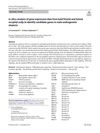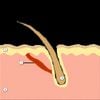Search
forLearn
5 / 6 resultslearn Neem Oil
natural substance from Neem tree with medicinal and pesticidal properties
learn Epidermal Growth Factor
learn Overview
learn Melatonin
hormone commonly taken for sleep aid has some topical benefits for hair
Research
5 / 1000+ resultsresearch Modeling Oxidative Stress-Linked Telogen Effluvium: A Monte Carlo Simulation Using Published Trichoscopy Norms and Cannabis Exposure Distributions
Higher cannabis exposure may worsen hair loss.

research In Silico Analysis of Gene Expression Data from Bald Frontal and Haired Occipital Scalp to Identify Candidate Genes in Male Androgenetic Alopecia
Found 32 genes linked to male baldness, affecting hair growth and stress-related pathways.
research Molybdenum Nanoparticles as a Potential Topical Medication for Alopecia Treatment Through Antioxidant Pathways That Differ from Minoxidil
Nano-sized molybdenum may help treat hair loss and works well with minoxidil.

research Integrated Meta-Analysis of Scalp Transcriptomics and Serum Proteomics Defines Alopecia Areata Subtypes and Core Disease Pathways
Early intervention in patch-type alopecia may prevent progression to more severe forms by targeting immune pathways and preserving keratin.

research A Natural Inhibitor, 1′S-1′-Acetoxychavicol Acetate, Against Testosterone-Induced Alopecia via NADPH Oxidase Regulation
1′S-1′-Acetoxychavicol acetate may help treat hair loss by reducing oxidative stress.
Community Join
5 / 108 results
community Compressed part of research of theory of androgenic/anabolitic balance. AGA h-responders analytic. Theory of physio-metabolitic method of anti AGA treatment
The treatment for androgenetic alopecia involves using finasteride and minoxidil with intense exercise and cold exposure to boost metabolism and reduce androgenic effects, potentially leading to hair regrowth. This approach may activate biological pathways for improved hair and overall health.
community The mechanism of androgenic alopecia
DHT may inhibit hair growth by affecting mitochondrial function, leading to hair follicle miniaturization. Treatments like minoxidil and PP405 may promote hair growth by altering metabolic pathways, potentially counteracting DHT's effects.
community How ET-02 Works. Also no proof that it's better than Minoxidil. At least for now.
ET-02, a PAI-1 inhibitor, is not proven to be more effective than Minoxidil for hair loss. Other treatments like finasteride, dutasteride, PP405, and AMP-303 are also discussed, focusing on cellular senescence and oxidative stress.
community A concise, easy-to-understand post on Androgenic Alopecia theory and its practical applications
The mechanism of Androgenic Alopecia and practical applications of treatments like Minoxidil, Finasteride, RU58841, dermarolling, scalp massages, anti-fungals, progesterone, estrogen, PPAR-γ activators, reducing oxidative stress, and scalp exercises. It explains why DHT is important in AA and how other factors might be involved such as hypoxia, increased DKK-1 expression, morphological changes to the scalp, skull growth during childhood/puberty, and blood flow.

community Physio-metabolic method of treating androgenic alopecia. Cold receptors. The relationship between DHT, cold receptors, minoxidil and antiandrogens
Treating androgenic alopecia with minoxidil, finasteride, and antiandrogens, alongside exercise, cryotherapy, and natural substances to stimulate cold receptors for better hair growth. The method focuses on enhancing treatment effectiveness by considering environmental and behavioral factors and the role of cold receptors and muscle stress.